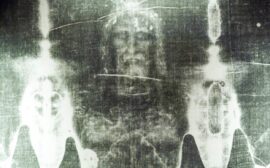By: Michelle Johnson, Ph.D., Cand. | May 2, 2022
Editorial Note: We give our readers the opportunity to ask questions of our staff concerning theology, apologetics, philosophy, and the Bible. Some of the questions are answered on the podcast, whereas others are addressed in articles. If you have a question that you would like to ask the Bellator Christi Team, go to https://bellatorchristi.com/submit-a-question-to-bellator-christi/ and fill out the form. Your question could be featured in a future article on BellatorChristi.com or an episode of the Bellator Christi Podcast.
Question:
“Contact with a leper should render Jesus ceremonially unclean (Num 5:1-4), but He is not defiled. Instead, His contact purifies the diseased man (Matt 8:3-4). Is that because Jesus is God?”
Answer:
Let’s start by looking at the two passages noted in the question.[1] Numbers 5:1-4 – The Israelites are in the wilderness, freed from Egypt but not yet in the Promised Land. God gives instructions to Moses that are to be passed on to the people. There were a handful of situations or conditions that would make a person ceremonially unclean (having an infectious skin disease – many say this wasn’t limited to what we know as leprosy, a bodily discharge, or having touched a dead body) and God commanded they be sent outside the camp so that it would not be defiled. This was important because He dwelt there, in the camp, among His people. The reader is told the people obeyed God’s command and the unclean were put outside the camp.
Matthew 8:3-4 – These are just two verses of what Matthew records in the first gospel. Chapter eight begins by telling us Jesus was coming down from the mountainside and a leper approached Him stating “Lord, if you are willing you can make me clean.” Jesus reaches out, touched the leper, and said He was willing. The leper is healed, and Jesus sends him off to follow the steps established by God (Leviticus 14) to be reunited with the community.
Four Perpectives
Based on the passage in Numbers is Jesus in Matthew 8 defiled? Here are a few perspectives:
- Some scholars say no, He was not defiled.
- One said yes, He was defiled and made the leper clean in an exchange.[2]
- Some say “technically” Jesus could be deemed defiled by the words of the law but in truth, He
followed the spirit of the law by healing the man.[3]
- Many seem to see this account as part of the larger purpose of Matthew’s writing – to testify to his primarily Jewish audience that King Jesus had come and doesn’t really answer the question.[4]
Context and the Kingdom of God
Reading the Matthew verses compels a serious Bible student to examine the context of the passage. The passages around these verses will help inform us as to Matthew’s overarching message. It is important to remember chapter numbers, verse numbers, and section headings were all added much later for the ease of navigating the text, they were not a part of the original manuscript. The previous chapters (Matt 5-7) record what we often call the “Sermon on the Mount.”
Jesus was teaching his disciples and the gathered crowd about how the Kingdom of God, His Kingdom would operate. He revisits the 10 commandments and explains things like murder and adultery were not simply the actions themselves but included the thoughts and heart motive behind the behavior. He taught about giving, treasure and worry. Matthew concludes his record of this teaching by saying “the crowds were amazed at his teaching, because he taught as one who had authority, and not as their teachers of the law.” (Matt 7:28-29) Jesus was demonstrating an authority that was unique to His divine identity.
Then Jesus comes down from the mountainside and is approached by the leper in our opening question. It is not only the leper that is healed but Matthew goes on to record in the next two chapters, Jesus’s healing Peter’s mother-in-law, a Roman centurion’s servant, demon-possessed men, a woman who suffered from 12 years of bleeding, and raising a dead girl. Matthew gives us a clue that he has chosen just a sampling of the healing stories when he tells us “…many…were brought to him…(he) healed all the sick” and “Jesus went through all the towns and villages…healing every disease and sickness.” (Matt 8:16; 9:35 respectively) There is scholarly agreement that Matthew’s purpose is to testify to the power and authority of King Jesus. His power extends over demons, disease, and death.
Conclusion and Application
Jesus did physically heal this leper, allowing him the opportunity to rejoin his community, worship in the Temple again, and enjoy the fellowship of others but there seems to be more. Most scholars seem to understand this healing as an illustration of what Jesus would accomplish for humankind on the cross. Sin has made all of us unclean. (Romans 3:23) As God told Moses in Numbers 5, the unclean could not be in His presence.
Like those who had a skin disease or had touched a dead body, we are unclean, defiled by sin, and separated. It is Jesus who reaches out, just as He did to the leper, and offers us the opportunity to become clean and reconciled to God. Jesus reached out and made the leper clean. Jesus came to earth, became fully man and fully God, lived a perfect life, and died on the cross to make us clean. He raised from the dead three days later and through Him we can be restored.
About the Author
 Michelle Johnson is a Ph.D. Candidate in the Theology and Apologetics program at Liberty University. She also earned her M.A. in Theological Studies and her M.Div. in Professional Ministries at Liberty University. Michelle graduated from the University of Minnesota with her undergraduate degrees. She and her husband Steve live in Mankato, Minnesota, where she also serves in women’s ministries. In addition to her love of theology and apologetics, Michelle also has a passion for historical studies, particularly the theology of the Patristics. When she is not spending time reading or writing, Michelle can often be found dreaming of her next travel adventure or enjoying a great cup of coffee. Michelle serves as the Managing Editor of Bellator Christi Ministries.
Michelle Johnson is a Ph.D. Candidate in the Theology and Apologetics program at Liberty University. She also earned her M.A. in Theological Studies and her M.Div. in Professional Ministries at Liberty University. Michelle graduated from the University of Minnesota with her undergraduate degrees. She and her husband Steve live in Mankato, Minnesota, where she also serves in women’s ministries. In addition to her love of theology and apologetics, Michelle also has a passion for historical studies, particularly the theology of the Patristics. When she is not spending time reading or writing, Michelle can often be found dreaming of her next travel adventure or enjoying a great cup of coffee. Michelle serves as the Managing Editor of Bellator Christi Ministries.
Notes
[1] All passages are from The Quest Study Bible NIV by Zondervan Publishers unless otherwise noted.
[2] Warren W. Wiersbe, The Bible Exposition Commentary (Wheaton, Il: Victor Books, 1989), 33.
[3] Michael Rydelnik and Michael G. Vanlaningham, eds., The Moody Bible Commentary (Chicago: Moody Publishers, 2014), 1466.
[4] John F. Walvoord and Roy B. Zuck, eds., The Bible Knowledge Commentary: An Exposition of the Scriptures New Testament (Wheaton, Il: Victor Books, 1983), 36. Rydelnik and Vanlaningham The Moody Bible Commentary and Ray C. Stedman, Adventuring Through the Bible: A Comprehensive Guide to the Entire Bible, 2nd New Enhanced ed (Grand Rapids, MI: Discovery House Publishers, 2012), 552. All these scholars focus upon Matthew’s intent to demonstrate Jesus is King.






Jason-
First, thank you for taking the time to read and comment on my article. Given the passages cited in the question, there is no direct way to answer the question about Jesus remaining undefiled. The Numbers passage (as mentioned in another comment by Dr. Percer) doesn’t address the issue of becoming defiled by touching a leper. It seems reasonable to assume Matthew’s original audience (as well as the modern reader) would wonder about Jesus’ cleanliness or uncleanliness. This is evidenced by the fact that commentators address this question (at least in passing) when writing on the Matthew passage. I suggested four of the responses in the article. But, as with the Number’s passage, I don’t understand these Matthew verses to be addressing this issue. As I mentioned in the article, Matthew’s inclusion of the story of Jesus and the leper in chapter 8 supports Matthew’s overarching purpose of showing King Jesus’ power and authority – here specifically His power and authority over disease.
Blessings!
Michelle
I’m struggling to see where the author answers the question of how Jesus remains clean after touching the unclean leper. TIA
Just a couple of comments. First, Numbers 5:1-4 has nothing to do with other people touching a person with a skin disease like leprosy. Rather, it has to do with isolating (or maybe quarantining) those people perhaps so that the disease will not spread. Second, Leviticus 5 warns against touching such a person unknowingly or unwillingly. That is, one can become unclean if one touches a leper without realizing the leper’s unclean status. Third, Leviticus 13 discusses the role of a priest of determining whether a skin disease renders a person as “clean” or “unclean.” To make this determination, the priest is to examine the skin of the infected person (willingly, that is) and perhaps even come into contact with the individual. This contact does not necessarily render the priest unclean. So, Jesus’ touching the leper (willingly) may have priestly implications. At the very least, Jesus touching the leper is a willing act, renders the man “clean” or healed, and does not necessarily mean that Jesus is unclean. As John Nolland (in the NIGNT commentary) says: “Despite the regular assumption of commentators, touching here does not seem to violate the rules of the cultic and ritual system.” See John Nolland, The Gospel of Matthew: A Commentary on the Greek Text, New International Greek Testament Commentary (Grand Rapids, MI; Carlisle: W.B. Eerdmans; Paternoster Press, 2005), 350. I hope that helps a bit!
Wonderful insights, Dr. Percer! I especially love your comment where you said that Jesus made the leper clean rather than the leper making Jesus unclean. So very true!
[…] Source: Jesus and the Leper in Matthew 8 […]